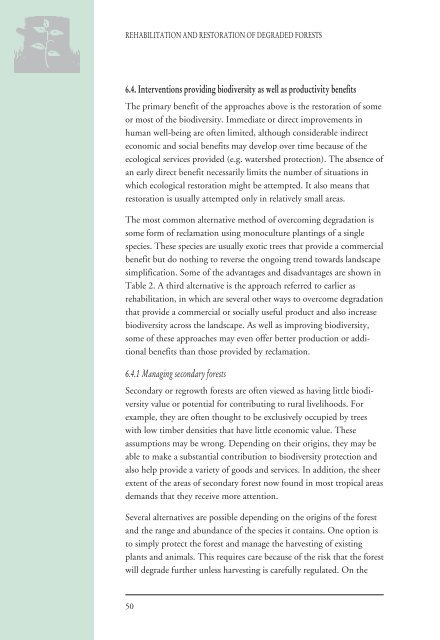Rehabilitation and Restoration Of Degraded Forests (PDF) - IUCN
Rehabilitation and Restoration Of Degraded Forests (PDF) - IUCN
Rehabilitation and Restoration Of Degraded Forests (PDF) - IUCN
Create successful ePaper yourself
Turn your PDF publications into a flip-book with our unique Google optimized e-Paper software.
REHABILITATION AND RESTORATION OF DEGRADED FORESTS<br />
6.4. Interventions providing biodiversity as well as productivity benefits<br />
The primary benefit of the approaches above is the restoration of some<br />
or most of the biodiversity. Immediate or direct improvements in<br />
human well-being are often limited, although considerable indirect<br />
economic <strong>and</strong> social benefits may develop over time because of the<br />
ecological services provided (e.g. watershed protection). The absence of<br />
an early direct benefit necessarily limits the number of situations in<br />
which ecological restoration might be attempted. It also means that<br />
restoration is usually attempted only in relatively small areas.<br />
The most common alternative method of overcoming degradation is<br />
some form of reclamation using monoculture plantings of a single<br />
species. These species are usually exotic trees that provide a commercial<br />
benefit but do nothing to reverse the ongoing trend towards l<strong>and</strong>scape<br />
simplification. Some of the advantages <strong>and</strong> disadvantages are shown in<br />
Table 2. A third alternative is the approach referred to earlier as<br />
rehabilitation, in which are several other ways to overcome degradation<br />
that provide a commercial or socially useful product <strong>and</strong> also increase<br />
biodiversity across the l<strong>and</strong>scape. As well as improving biodiversity,<br />
some of these approaches may even offer better production or additional<br />
benefits than those provided by reclamation.<br />
6.4.1 Managing secondary forests<br />
Secondary or regrowth forests are often viewed as having little biodiversity<br />
value or potential for contributing to rural livelihoods. For<br />
example, they are often thought to be exclusively occupied by trees<br />
with low timber densities that have little economic value. These<br />
assumptions may be wrong. Depending on their origins, they may be<br />
able to make a substantial contribution to biodiversity protection <strong>and</strong><br />
also help provide a variety of goods <strong>and</strong> services. In addition, the sheer<br />
extent of the areas of secondary forest now found in most tropical areas<br />
dem<strong>and</strong>s that they receive more attention.<br />
Several alternatives are possible depending on the origins of the forest<br />
<strong>and</strong> the range <strong>and</strong> abundance of the species it contains. One option is<br />
to simply protect the forest <strong>and</strong> manage the harvesting of existing<br />
plants <strong>and</strong> animals. This requires care because of the risk that the forest<br />
will degrade further unless harvesting is carefully regulated. On the<br />
50

















